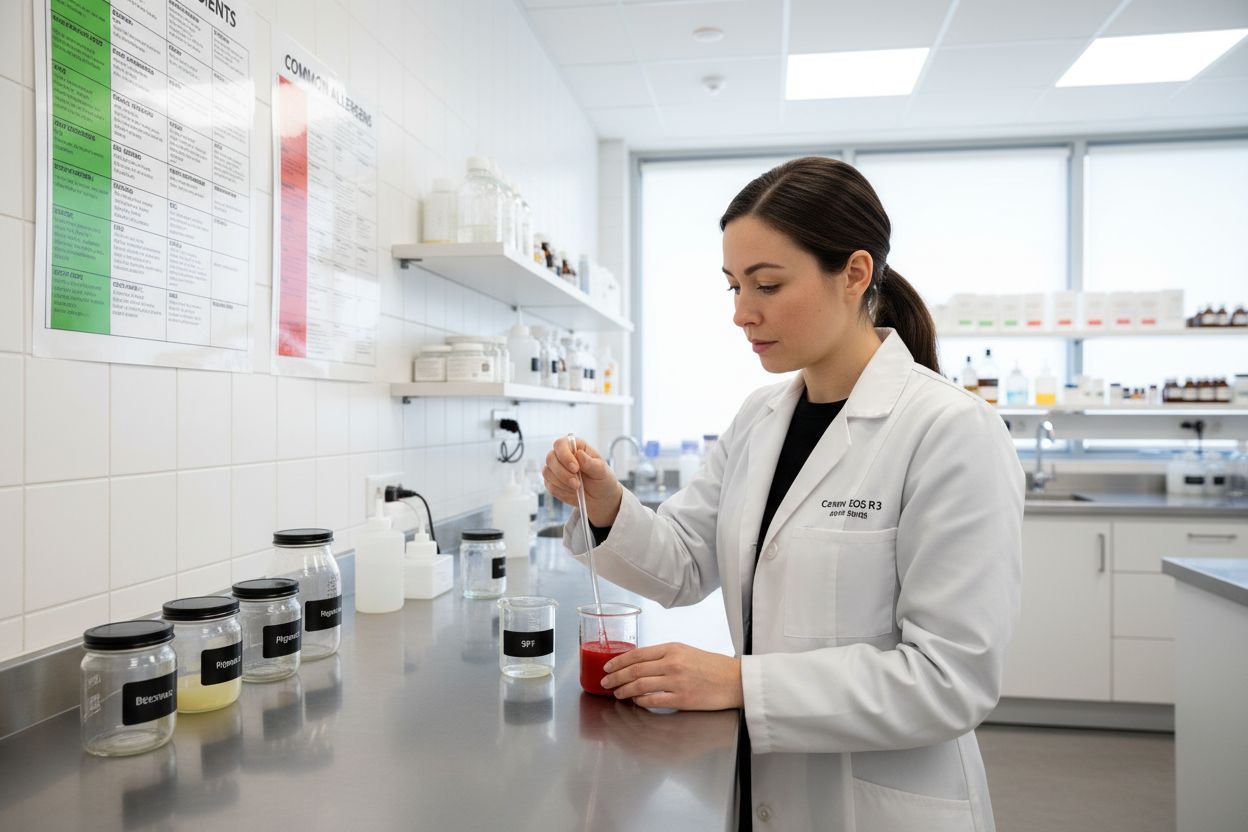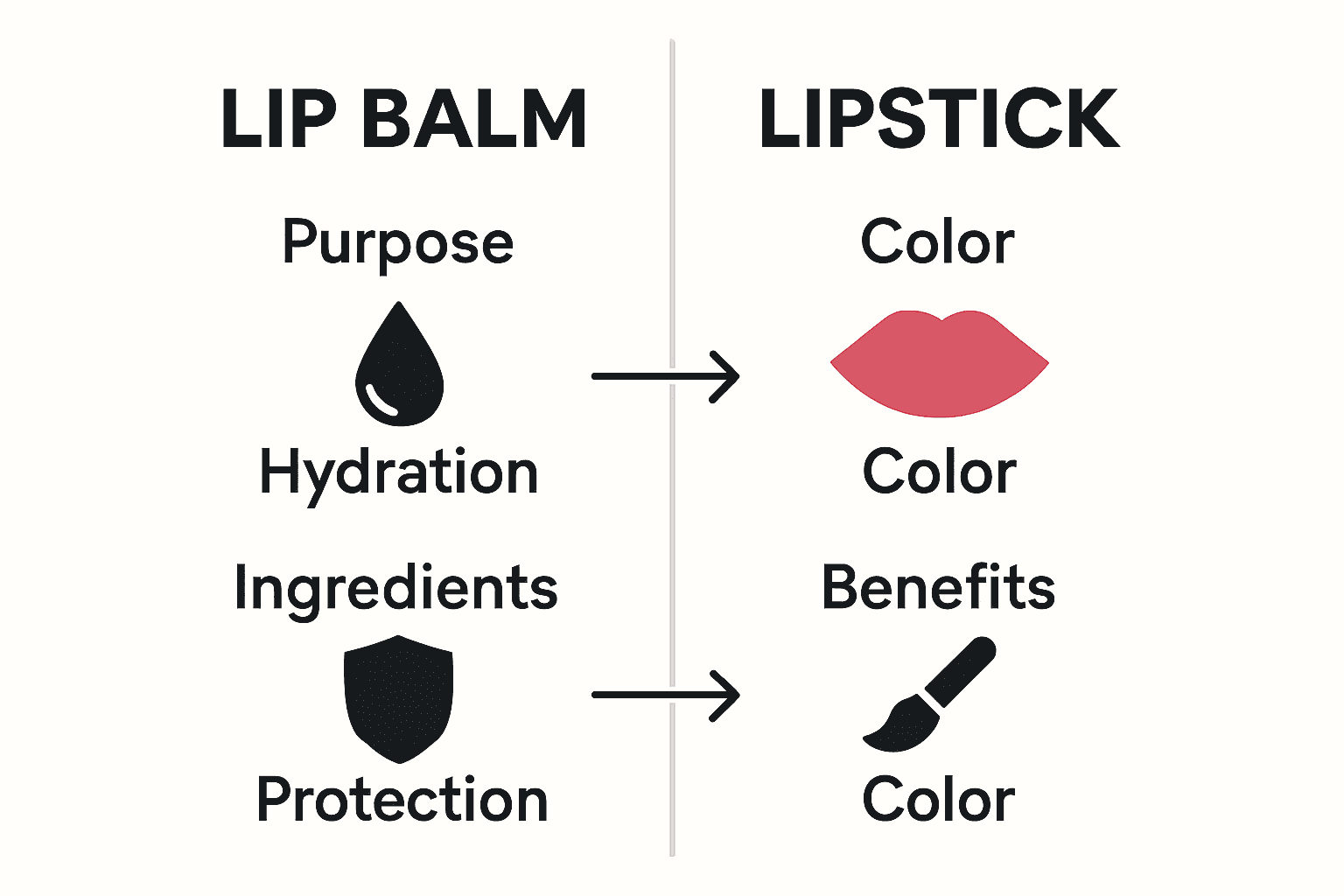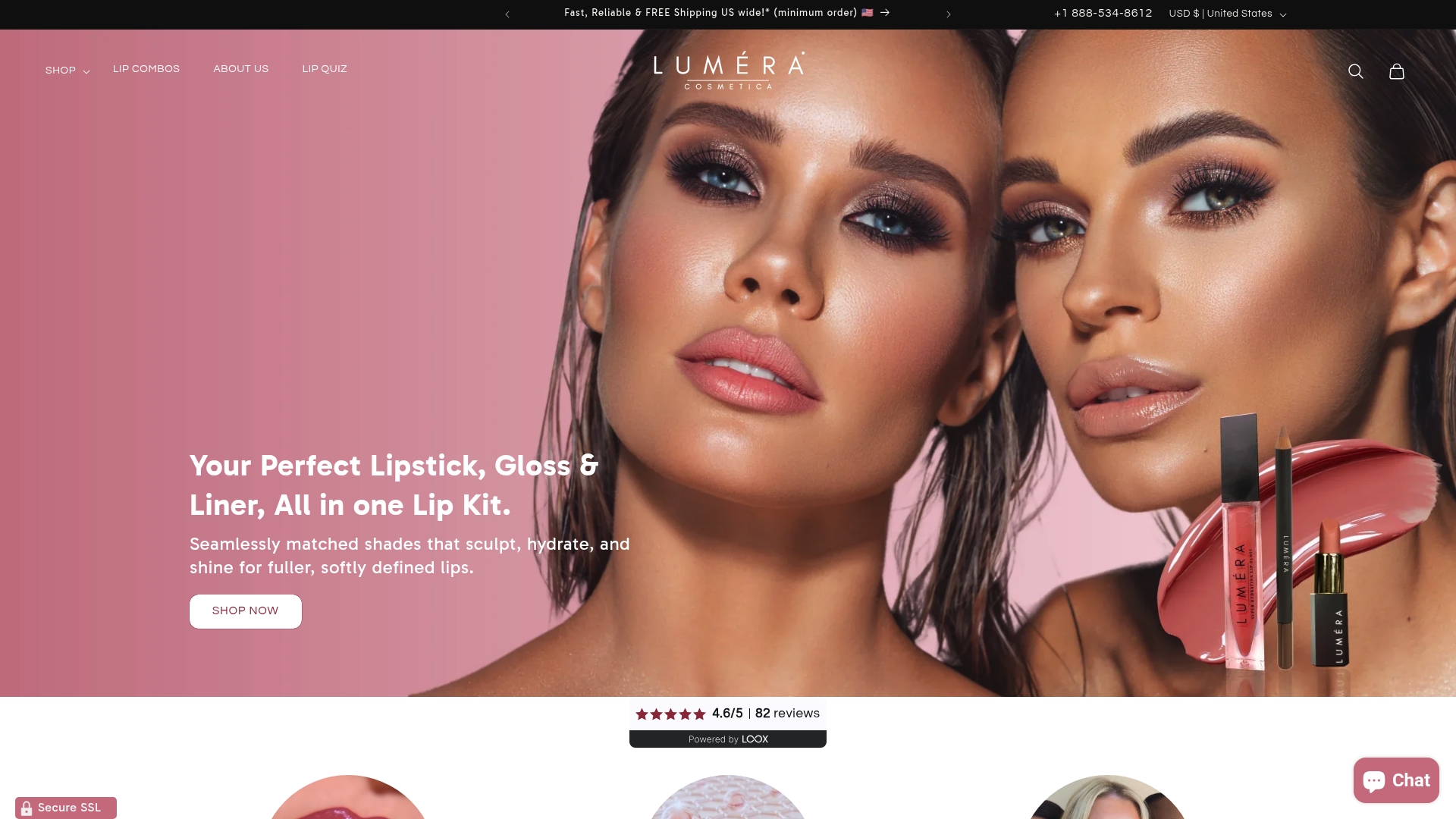Did you know that people apply lip products nearly 12 times a day on average? Choosing between lip balm and lipstick is more than a fashion statement. It can mean healthier lips or a bold new look. Understanding what sets these two products apart helps you care for your lips while expressing your personal style in the best way possible.
Key Takeaways
| Point | Details |
|---|---|
| Purpose Differentiation | Lip balm focuses on hydration and protection, while lipstick emphasizes color and visual enhancement. |
| Ingredient Disclosure | Lip balms typically contain nourishing oils and waxes, whereas lipsticks consist of pigments and specialized waxes. |
| Application Frequency | Lip balm should be reapplied multiple times daily for effective hydration; lipstick is applied as needed. |
| Safety Awareness | It’s crucial to check ingredient lists for potential allergens and harmful substances, particularly in lipsticks. |
 |
|
Table of Contents
- Core Differences Between Lip Balm and Lipstick
- Types and Variations of Lip Balms and Lipsticks
- How Lip Balm and Lipstick Work
- Ingredients and Benefits for Mature Lips
- Comparing Safety, Allergies, and Regulations
- Choosing the Right Product for Your Needs
Core Differences Between Lip Balm and Lipstick
When it comes to lip care and cosmetics, lipstick and lip balm might seem similar at first glance, but they serve distinctly different purposes. According to cosmeticscientist.com, these two products have fundamental differences in their formulation and primary objectives.
Lipstick is primarily a cosmetic product focused on aesthetic enhancement. It’s designed to add vibrant color and visual appeal to your lips, available in an incredible range of shades from subtle nudes to bold reds. The formulation typically includes pigments, specialized waxes, and oils that help create long-lasting color and a polished look. Read more about lipstick varieties in our comprehensive guide.
In contrast, lip balm is all about lip health and protection. Its core mission is moisturizing and shielding your delicate lip skin from environmental damage. Most lip balms incorporate nourishing ingredients like:
- Natural oils
- Beeswax
- Petroleum jelly
- Vitamin E
- SPF protection
While lipstick transforms your appearance, lip balm ensures your lips remain soft, hydrated, and comfortable. They’re less about visual drama and more about maintaining your lips’ natural moisture barrier and preventing chapping, especially during harsh weather conditions.
Here’s a comparison of the key differences between lip balm and lipstick:

| Feature | Lip Balm | Lipstick |
|---|---|---|
| Main Purpose | Hydration Protection |
Color enhancement Visual impact |
| Typical Ingredients | Oils Beeswax Petroleum jelly SPF |
Pigments Waxes Oils |
| Primary Benefit | Moisturizes Shields from environment |
Adds color Defines lips |
| Application Frequency | Multiple times per day | As needed Less frequent |
| Visual Effect | Sheer Natural finish |
Wide range of colors Various finishes |
| Specialized Types | Tinted Medicated SPF Organic |
Creamy Matte Glossy Liquid |
Types and Variations of Lip Balms and Lipsticks
Lip balms and lipsticks offer far more variety than most people realize. According to Maybelline’s research, each product category features multiple types designed to address specific beauty and skincare needs.
Lip Balm Variations
Lip balms aren’t just simple moisturizing products anymore. They’ve evolved into specialized solutions targeting different concerns. Discover our detailed guide on lipstick finishes to understand the nuanced world of lip products. The main types of lip balms include:
- Tinted Balms: Offer subtle color while hydrating
- Moisturizing Balms: Focused on deep lip hydration
- Medicated Balms: Help heal chapped or damaged lips
- SPF Balms: Provide sun protection for delicate lip skin
- Organic Balms: Made with natural, chemical-free ingredients
Lipstick Varieties
Lipsticks are even more diverse, with finishes and formats that can dramatically change your look. From the classic bullet lipstick to modern liquid formulations, you have countless options. The primary lipstick types include:
- Creamy Lipsticks: Smooth, moisturizing finish
- Matte Lipsticks: Flat, non-reflective color
- Glossy Lipsticks: Shiny, wet-look appearance
- Satin Lipsticks: Soft, subtle sheen
- Liquid Lipsticks: Precise application with long-lasting color
- Lip Crayons: Easy, pencil-like application
Whether you’re looking for intense color, subtle enhancement, or lip protection, there’s a product designed specifically for your needs.
How Lip Balm and Lipstick Work
Understanding the mechanics behind lip balm and lipstick reveals fascinating insights into their unique functions and interactions with our delicate lip skin. Learn more about creating the perfect lip look and how these products work their magic.
The Science of Lip Balm
According to the Associated Press, lip balm operates by creating a protective barrier that seals moisture into the lips. This is critical because lip skin lacks the natural protective layer found on other parts of our body. As reported by Time magazine, lip balms form a temporary shield preventing moisture loss, though they require frequent reapplication as the protective layer wears off.
Key Mechanisms of Lip Balm:
- Creates a moisture-sealing barrier
- Prevents environmental damage
- Temporarily protects lip skin
- Helps restore hydration
Lipstick’s Functional Design
Lipstick goes beyond mere protection, focusing on aesthetic enhancement and color delivery. Its complex formulation includes pigments, waxes, and oils designed to adhere to lip skin, providing long-lasting color and a polished appearance. Unlike lip balms, lipsticks prioritize visual transformation while offering minimal moisture protection.
Warning: Some lip balm ingredients like menthol, fragrances, or plumping agents can cause skin irritation. Always patch test new products and monitor your skin’s response.
Ingredients and Benefits for Mature Lips
As we age, our lips require more specialized care and attention. Discover the best lipstick shades for mature skin, keeping both beauty and skin health in mind.
Hydration-Focused Ingredients
According to Byrdie, mature lips benefit tremendously from specific hydrating ingredients. The key ingredients that support lip health include:
- Hyaluronic Acid: Intense moisture retention
- Coconut Oil: Natural hydration and softening
- Vitamin E: Healing and protective properties
- Beeswax: Creates protective moisture barrier
- Jojoba Oil: Mimics natural skin oils
These ingredients work synergistically to combat the natural loss of moisture and elasticity that occurs with aging. They help repair the lip barrier, preventing further dryness and reducing the appearance of fine lines.
Choosing the Right Formulations
Who What Wear emphasizes that mature lips should avoid overly matte or drying lipstick formulas. Instead, look for products enriched with nourishing oils and hydrating compounds. Creamy, comfortable lipsticks that provide moisture while delivering color are ideal.
Pro Tip: Always apply a hydrating lip balm underneath lipstick to create a smooth, protective base that prevents color bleeding and keeps lips looking plump and youthful.
Comparing Safety, Allergies, and Regulations
Safety should be a top priority when selecting lip products, and understanding potential risks is crucial for making informed choices. Learn more about choosing safe lip products, especially for those with sensitive skin.
Potential Allergens and Irritants
According to the Associated Press, lip balms can contain several ingredients that might trigger allergic reactions. Potential irritants include:
- Fragrances: Common allergy triggers
- Preservatives: Such as formaldehyde
- Lanolin: Natural ingredient that can cause sensitivity
- Oxybenzone: Potential skin irritant
For individuals with sensitive lips, fragrance-free and petroleum-based balms are often the safest option. Always perform a patch test before regular use to ensure no adverse reactions.
Regulatory Concerns in Lipstick
Wikipedia highlights emerging concerns about toxic materials in lipstick formulations. Traces of potentially harmful substances like lead and PFAS (Per- and Polyfluoroalkyl Substances) have prompted increased regulatory scrutiny in the cosmetics industry.
Safety Recommendations:
- Check ingredient lists carefully
- Choose products from reputable brands
- Look for third-party safety certifications
- Avoid products with known irritants
Staying informed and vigilant about product ingredients is the best way to protect your lip health while enjoying beautiful cosmetics.
Choosing the Right Product for Your Needs
Selecting between lip balm and lipstick isn’t just about aesthetics—it’s about understanding your specific lip care and beauty goals. Explore our comprehensive guide to finding your perfect lip product, tailored to your unique needs.
Determining Your Primary Objective
According to McAffeine’s research, your choice depends on your immediate requirements. Lip balm is ideal when you’re seeking:
- Intense hydration
- Daily protection
- Sun protection (with SPF)
- Minimal makeup appearance
Lipstick becomes the preferred option when you want:
- Bold, defined color
- Long-lasting makeup look
- Precise application
- Structured lip definition
Strategic Product Layering
Divafresh suggests a brilliant compromise: layering products for optimal results. Start with a hydrating lip balm as a base, then apply lipstick on top. This approach combines moisture protection with vibrant color, addressing multiple lip care needs simultaneously.
Pro Tip: Consider your daily activities, skin type, and personal style when making your selection. There’s no one-size-fits-all solution—the perfect lip product is the one that makes you feel confident and comfortable.
Unlock Healthier, More Beautiful Lips with Luméra Cosmetica
If you are struggling to choose between lip balm and lipstick for daily comfort or vibrant transformation, Luméra Cosmetica has you covered. The article explored how important it is to hydrate and protect your lips without sacrificing style or color. Our LIP OIL collection is the perfect solution, offering nourishment and a natural glow that bridges the best benefits of both worlds.

Ready for lips that look as good as they feel? Experience gentle hydration, luminous shine, and effortless color with our premium lip care essentials. Visit Luméra Cosmetica today and find your ideal match. Reimagine your beauty routine without compromise and shop our LIP OIL or explore new favorites in our Eye Collection while you invest in healthier, more confident lips now.
Frequently Asked Questions
What is the main difference between lip balm and lipstick?
Lip balm primarily focuses on moisturizing and protecting the lips, while lipstick is designed to enhance appearance with color and shine.
How often should I apply lip balm compared to lipstick?
Lip balm should be applied multiple times a day for optimal hydration, while lipstick is typically reapplied less frequently, depending on wear and food consumption.
What are the key ingredients to look for in lip balm?
Look for ingredients like natural oils, beeswax, petroleum jelly, vitamin E, and SPF for effective hydration and protection in lip balms.
Can I use lip balm under lipstick?
Yes, using a hydrating lip balm underneath lipstick creates a smooth base, preventing color bleeding and ensuring a more comfortable wear.

